CNA672 Research for Clinical Practice: Qualitative Research Appraisal
VerifiedAdded on 2022/09/07
|8
|1803
|18
Homework Assignment
AI Summary
This assignment is a critical appraisal of a qualitative research article, focusing on interprofessional clinicians' definitions of moral resilience. The student used the CASP (Critical Appraisal Skills Programme) tool to evaluate the research design, recruitment strategy, data collection methods, data analysis rigor, findings, and overall value of the research. The appraisal includes detailed explanations and justifications for each assessment criterion, providing insights into the study's strengths and weaknesses. The student highlights the appropriateness of the qualitative descriptive method, the recruitment of interprofessional clinicians, and the data collection methods used to define moral resilience. The analysis process, thematic analysis, and the findings, including primary and subthemes, are also assessed. Finally, the student discusses the value of the research in contributing to the understanding of moral resilience and its implications for healthcare professionals. The assignment demonstrates a strong understanding of qualitative research methodology and critical appraisal techniques.
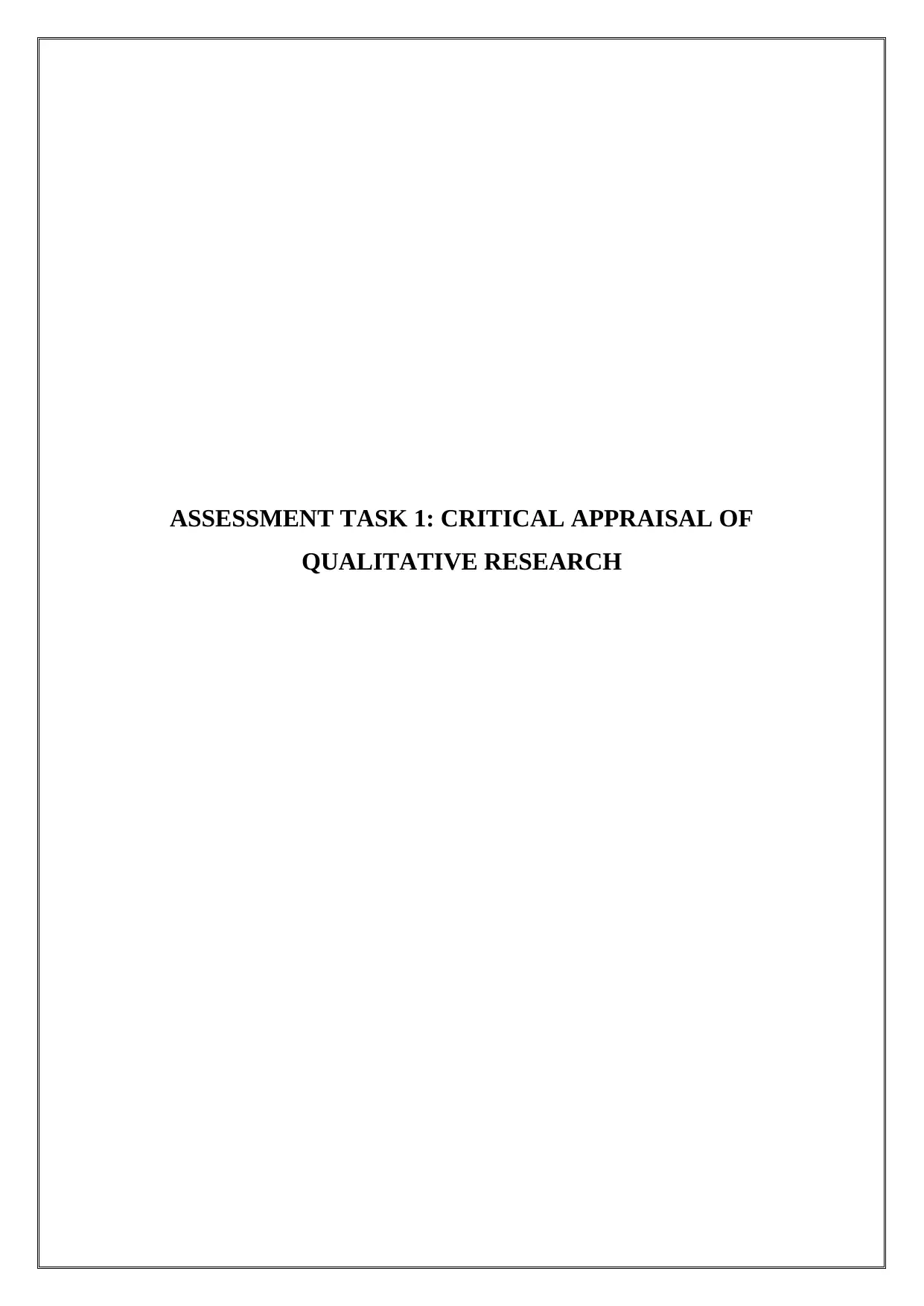
ASSESSMENT TASK 1: CRITICAL APPRAISAL OF
QUALITATIVE RESEARCH
QUALITATIVE RESEARCH
Paraphrase This Document
Need a fresh take? Get an instant paraphrase of this document with our AI Paraphraser
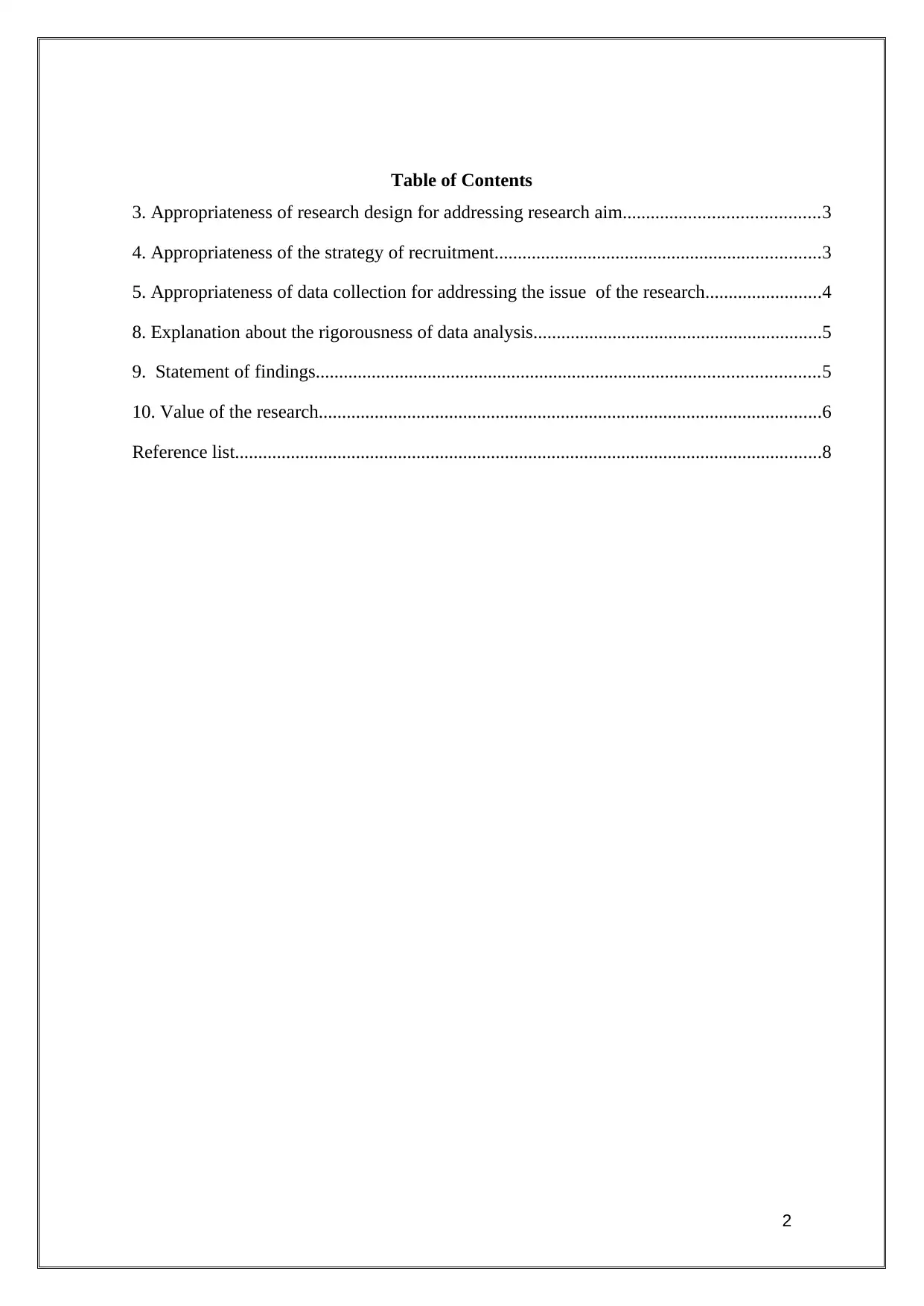
Table of Contents
3. Appropriateness of research design for addressing research aim..........................................3
4. Appropriateness of the strategy of recruitment......................................................................3
5. Appropriateness of data collection for addressing the issue of the research.........................4
8. Explanation about the rigorousness of data analysis..............................................................5
9. Statement of findings............................................................................................................5
10. Value of the research............................................................................................................6
Reference list..............................................................................................................................8
2
3. Appropriateness of research design for addressing research aim..........................................3
4. Appropriateness of the strategy of recruitment......................................................................3
5. Appropriateness of data collection for addressing the issue of the research.........................4
8. Explanation about the rigorousness of data analysis..............................................................5
9. Statement of findings............................................................................................................5
10. Value of the research............................................................................................................6
Reference list..............................................................................................................................8
2
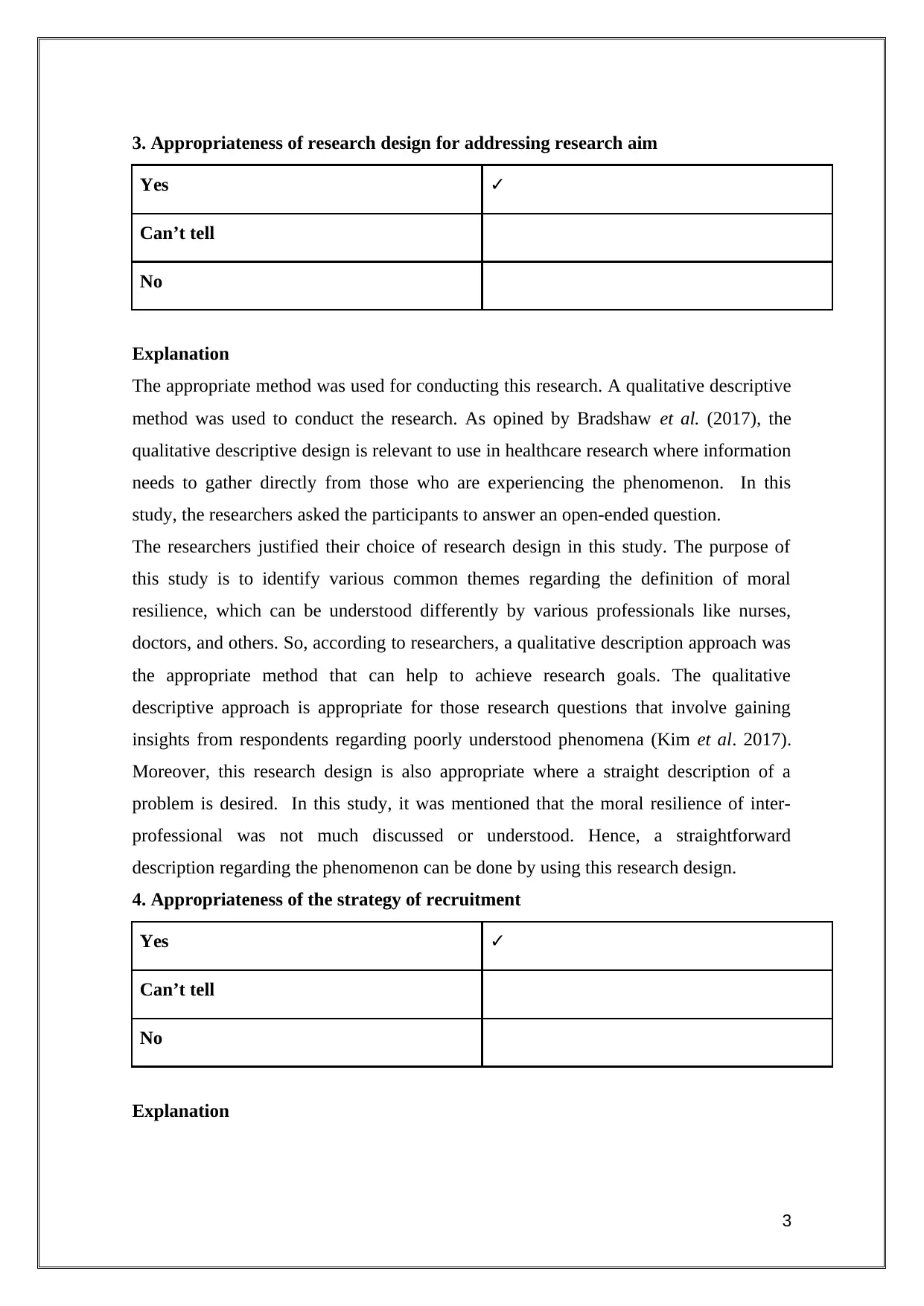
3. Appropriateness of research design for addressing research aim
Yes ✓
Can’t tell
No
Explanation
The appropriate method was used for conducting this research. A qualitative descriptive
method was used to conduct the research. As opined by Bradshaw et al. (2017), the
qualitative descriptive design is relevant to use in healthcare research where information
needs to gather directly from those who are experiencing the phenomenon. In this
study, the researchers asked the participants to answer an open-ended question.
The researchers justified their choice of research design in this study. The purpose of
this study is to identify various common themes regarding the definition of moral
resilience, which can be understood differently by various professionals like nurses,
doctors, and others. So, according to researchers, a qualitative description approach was
the appropriate method that can help to achieve research goals. The qualitative
descriptive approach is appropriate for those research questions that involve gaining
insights from respondents regarding poorly understood phenomena (Kim et al. 2017).
Moreover, this research design is also appropriate where a straight description of a
problem is desired. In this study, it was mentioned that the moral resilience of inter-
professional was not much discussed or understood. Hence, a straightforward
description regarding the phenomenon can be done by using this research design.
4. Appropriateness of the strategy of recruitment
Yes ✓
Can’t tell
No
Explanation
3
Yes ✓
Can’t tell
No
Explanation
The appropriate method was used for conducting this research. A qualitative descriptive
method was used to conduct the research. As opined by Bradshaw et al. (2017), the
qualitative descriptive design is relevant to use in healthcare research where information
needs to gather directly from those who are experiencing the phenomenon. In this
study, the researchers asked the participants to answer an open-ended question.
The researchers justified their choice of research design in this study. The purpose of
this study is to identify various common themes regarding the definition of moral
resilience, which can be understood differently by various professionals like nurses,
doctors, and others. So, according to researchers, a qualitative description approach was
the appropriate method that can help to achieve research goals. The qualitative
descriptive approach is appropriate for those research questions that involve gaining
insights from respondents regarding poorly understood phenomena (Kim et al. 2017).
Moreover, this research design is also appropriate where a straight description of a
problem is desired. In this study, it was mentioned that the moral resilience of inter-
professional was not much discussed or understood. Hence, a straightforward
description regarding the phenomenon can be done by using this research design.
4. Appropriateness of the strategy of recruitment
Yes ✓
Can’t tell
No
Explanation
3
⊘ This is a preview!⊘
Do you want full access?
Subscribe today to unlock all pages.

Trusted by 1+ million students worldwide
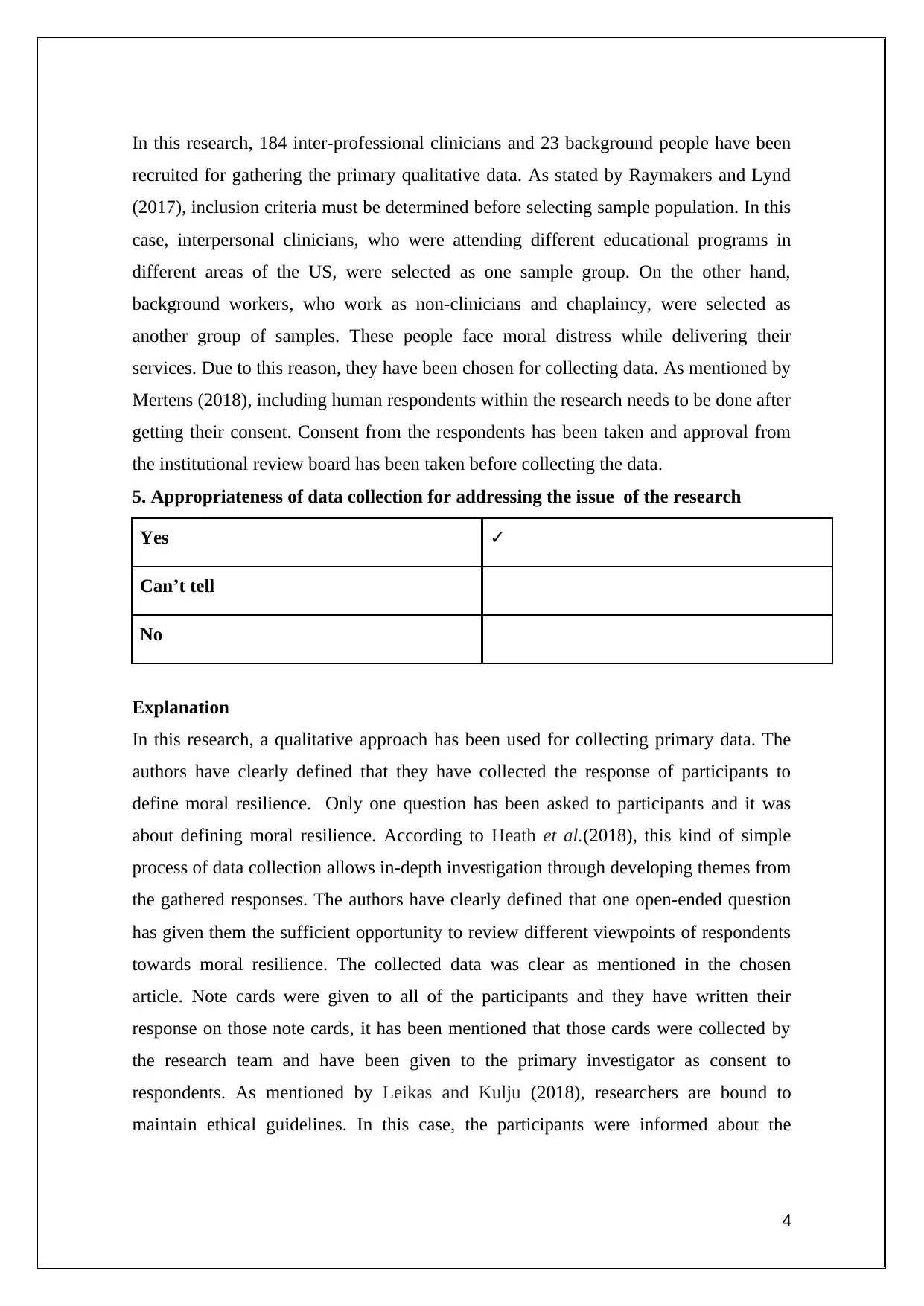
In this research, 184 inter-professional clinicians and 23 background people have been
recruited for gathering the primary qualitative data. As stated by Raymakers and Lynd
(2017), inclusion criteria must be determined before selecting sample population. In this
case, interpersonal clinicians, who were attending different educational programs in
different areas of the US, were selected as one sample group. On the other hand,
background workers, who work as non-clinicians and chaplaincy, were selected as
another group of samples. These people face moral distress while delivering their
services. Due to this reason, they have been chosen for collecting data. As mentioned by
Mertens (2018), including human respondents within the research needs to be done after
getting their consent. Consent from the respondents has been taken and approval from
the institutional review board has been taken before collecting the data.
5. Appropriateness of data collection for addressing the issue of the research
Yes ✓
Can’t tell
No
Explanation
In this research, a qualitative approach has been used for collecting primary data. The
authors have clearly defined that they have collected the response of participants to
define moral resilience. Only one question has been asked to participants and it was
about defining moral resilience. According to Heath et al.(2018), this kind of simple
process of data collection allows in-depth investigation through developing themes from
the gathered responses. The authors have clearly defined that one open-ended question
has given them the sufficient opportunity to review different viewpoints of respondents
towards moral resilience. The collected data was clear as mentioned in the chosen
article. Note cards were given to all of the participants and they have written their
response on those note cards, it has been mentioned that those cards were collected by
the research team and have been given to the primary investigator as consent to
respondents. As mentioned by Leikas and Kulju (2018), researchers are bound to
maintain ethical guidelines. In this case, the participants were informed about the
4
recruited for gathering the primary qualitative data. As stated by Raymakers and Lynd
(2017), inclusion criteria must be determined before selecting sample population. In this
case, interpersonal clinicians, who were attending different educational programs in
different areas of the US, were selected as one sample group. On the other hand,
background workers, who work as non-clinicians and chaplaincy, were selected as
another group of samples. These people face moral distress while delivering their
services. Due to this reason, they have been chosen for collecting data. As mentioned by
Mertens (2018), including human respondents within the research needs to be done after
getting their consent. Consent from the respondents has been taken and approval from
the institutional review board has been taken before collecting the data.
5. Appropriateness of data collection for addressing the issue of the research
Yes ✓
Can’t tell
No
Explanation
In this research, a qualitative approach has been used for collecting primary data. The
authors have clearly defined that they have collected the response of participants to
define moral resilience. Only one question has been asked to participants and it was
about defining moral resilience. According to Heath et al.(2018), this kind of simple
process of data collection allows in-depth investigation through developing themes from
the gathered responses. The authors have clearly defined that one open-ended question
has given them the sufficient opportunity to review different viewpoints of respondents
towards moral resilience. The collected data was clear as mentioned in the chosen
article. Note cards were given to all of the participants and they have written their
response on those note cards, it has been mentioned that those cards were collected by
the research team and have been given to the primary investigator as consent to
respondents. As mentioned by Leikas and Kulju (2018), researchers are bound to
maintain ethical guidelines. In this case, the participants were informed about the
4
Paraphrase This Document
Need a fresh take? Get an instant paraphrase of this document with our AI Paraphraser
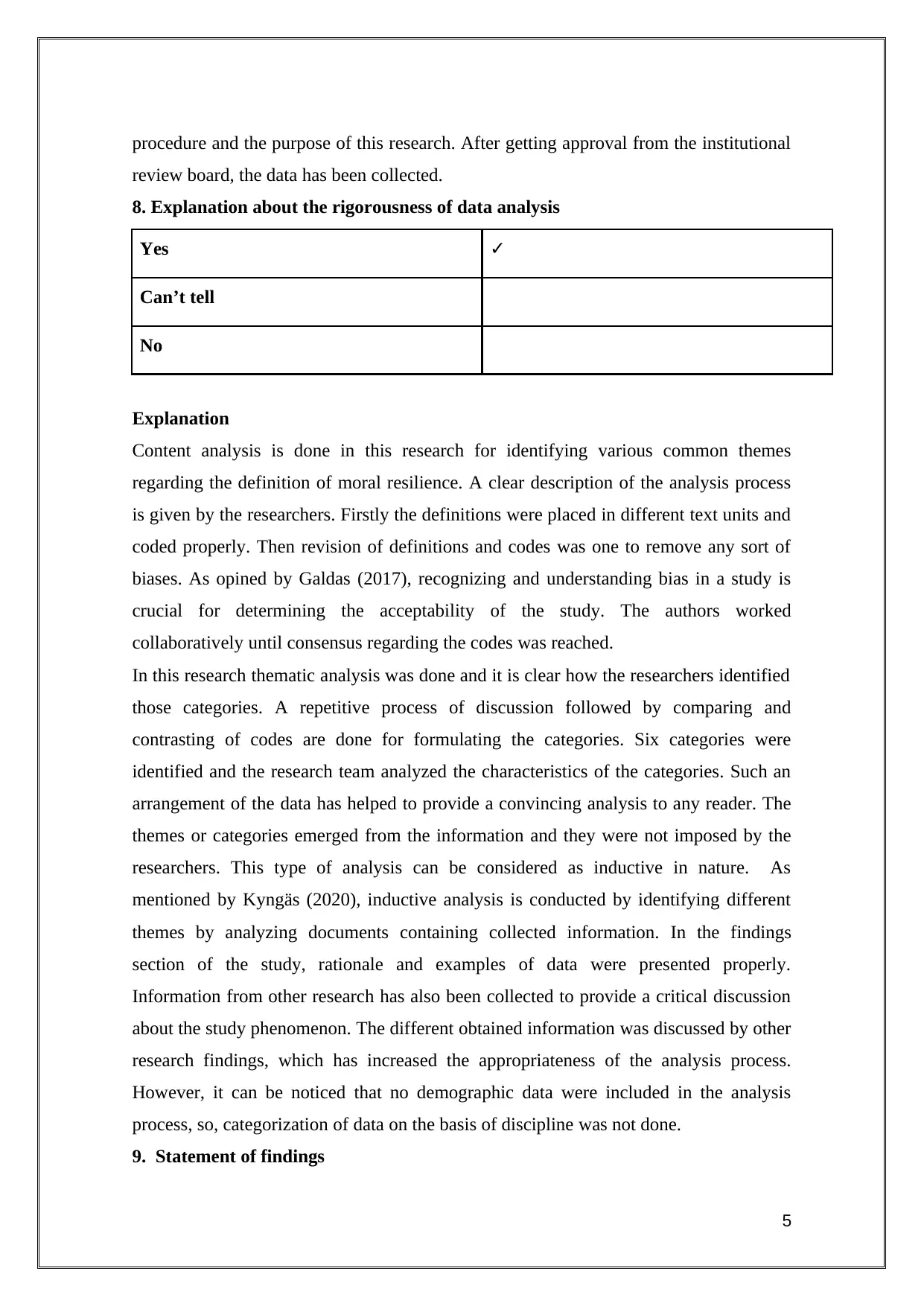
procedure and the purpose of this research. After getting approval from the institutional
review board, the data has been collected.
8. Explanation about the rigorousness of data analysis
Yes ✓
Can’t tell
No
Explanation
Content analysis is done in this research for identifying various common themes
regarding the definition of moral resilience. A clear description of the analysis process
is given by the researchers. Firstly the definitions were placed in different text units and
coded properly. Then revision of definitions and codes was one to remove any sort of
biases. As opined by Galdas (2017), recognizing and understanding bias in a study is
crucial for determining the acceptability of the study. The authors worked
collaboratively until consensus regarding the codes was reached.
In this research thematic analysis was done and it is clear how the researchers identified
those categories. A repetitive process of discussion followed by comparing and
contrasting of codes are done for formulating the categories. Six categories were
identified and the research team analyzed the characteristics of the categories. Such an
arrangement of the data has helped to provide a convincing analysis to any reader. The
themes or categories emerged from the information and they were not imposed by the
researchers. This type of analysis can be considered as inductive in nature. As
mentioned by Kyngäs (2020), inductive analysis is conducted by identifying different
themes by analyzing documents containing collected information. In the findings
section of the study, rationale and examples of data were presented properly.
Information from other research has also been collected to provide a critical discussion
about the study phenomenon. The different obtained information was discussed by other
research findings, which has increased the appropriateness of the analysis process.
However, it can be noticed that no demographic data were included in the analysis
process, so, categorization of data on the basis of discipline was not done.
9. Statement of findings
5
review board, the data has been collected.
8. Explanation about the rigorousness of data analysis
Yes ✓
Can’t tell
No
Explanation
Content analysis is done in this research for identifying various common themes
regarding the definition of moral resilience. A clear description of the analysis process
is given by the researchers. Firstly the definitions were placed in different text units and
coded properly. Then revision of definitions and codes was one to remove any sort of
biases. As opined by Galdas (2017), recognizing and understanding bias in a study is
crucial for determining the acceptability of the study. The authors worked
collaboratively until consensus regarding the codes was reached.
In this research thematic analysis was done and it is clear how the researchers identified
those categories. A repetitive process of discussion followed by comparing and
contrasting of codes are done for formulating the categories. Six categories were
identified and the research team analyzed the characteristics of the categories. Such an
arrangement of the data has helped to provide a convincing analysis to any reader. The
themes or categories emerged from the information and they were not imposed by the
researchers. This type of analysis can be considered as inductive in nature. As
mentioned by Kyngäs (2020), inductive analysis is conducted by identifying different
themes by analyzing documents containing collected information. In the findings
section of the study, rationale and examples of data were presented properly.
Information from other research has also been collected to provide a critical discussion
about the study phenomenon. The different obtained information was discussed by other
research findings, which has increased the appropriateness of the analysis process.
However, it can be noticed that no demographic data were included in the analysis
process, so, categorization of data on the basis of discipline was not done.
9. Statement of findings
5
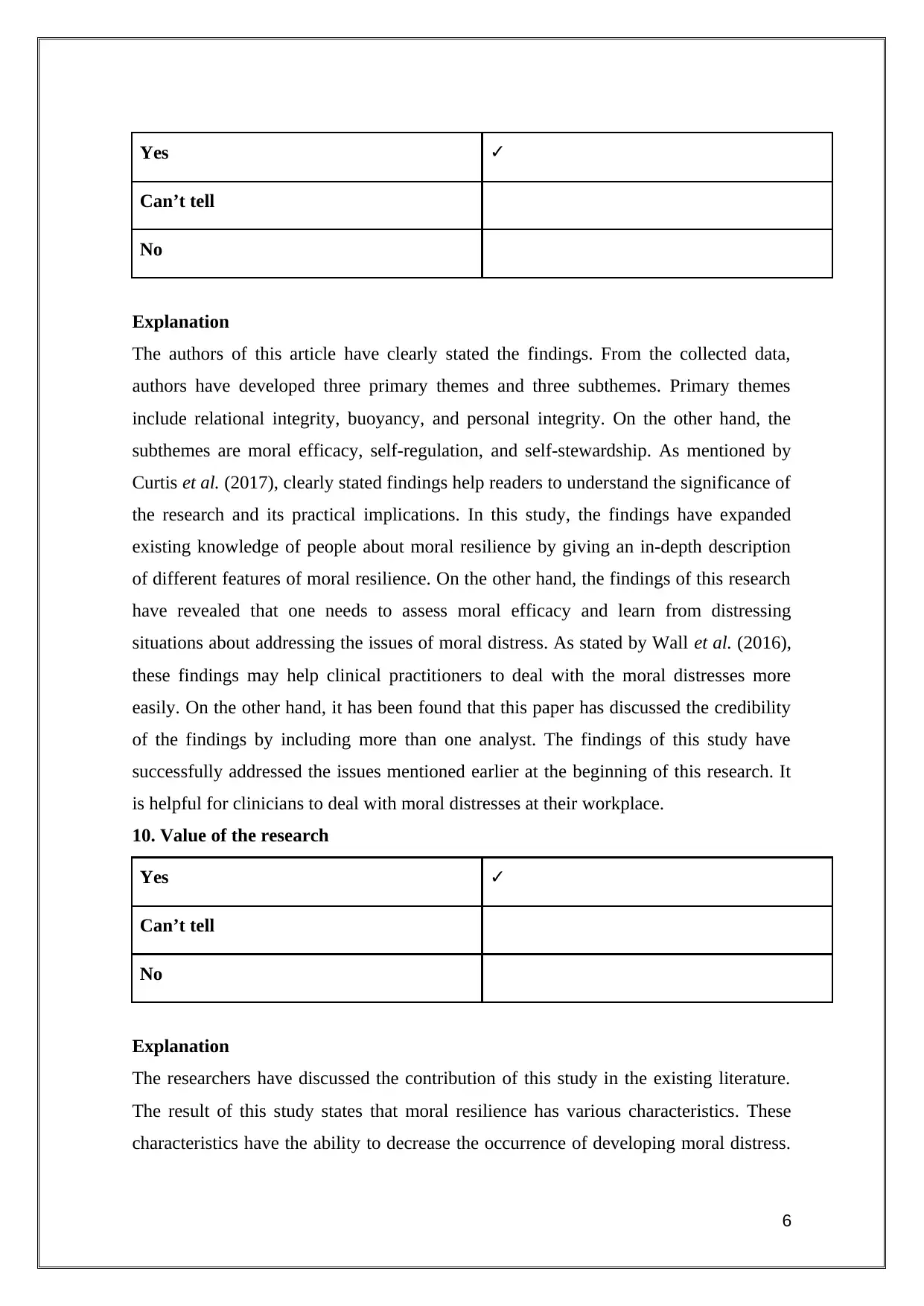
Yes ✓
Can’t tell
No
Explanation
The authors of this article have clearly stated the findings. From the collected data,
authors have developed three primary themes and three subthemes. Primary themes
include relational integrity, buoyancy, and personal integrity. On the other hand, the
subthemes are moral efficacy, self-regulation, and self-stewardship. As mentioned by
Curtis et al. (2017), clearly stated findings help readers to understand the significance of
the research and its practical implications. In this study, the findings have expanded
existing knowledge of people about moral resilience by giving an in-depth description
of different features of moral resilience. On the other hand, the findings of this research
have revealed that one needs to assess moral efficacy and learn from distressing
situations about addressing the issues of moral distress. As stated by Wall et al. (2016),
these findings may help clinical practitioners to deal with the moral distresses more
easily. On the other hand, it has been found that this paper has discussed the credibility
of the findings by including more than one analyst. The findings of this study have
successfully addressed the issues mentioned earlier at the beginning of this research. It
is helpful for clinicians to deal with moral distresses at their workplace.
10. Value of the research
Yes ✓
Can’t tell
No
Explanation
The researchers have discussed the contribution of this study in the existing literature.
The result of this study states that moral resilience has various characteristics. These
characteristics have the ability to decrease the occurrence of developing moral distress.
6
Can’t tell
No
Explanation
The authors of this article have clearly stated the findings. From the collected data,
authors have developed three primary themes and three subthemes. Primary themes
include relational integrity, buoyancy, and personal integrity. On the other hand, the
subthemes are moral efficacy, self-regulation, and self-stewardship. As mentioned by
Curtis et al. (2017), clearly stated findings help readers to understand the significance of
the research and its practical implications. In this study, the findings have expanded
existing knowledge of people about moral resilience by giving an in-depth description
of different features of moral resilience. On the other hand, the findings of this research
have revealed that one needs to assess moral efficacy and learn from distressing
situations about addressing the issues of moral distress. As stated by Wall et al. (2016),
these findings may help clinical practitioners to deal with the moral distresses more
easily. On the other hand, it has been found that this paper has discussed the credibility
of the findings by including more than one analyst. The findings of this study have
successfully addressed the issues mentioned earlier at the beginning of this research. It
is helpful for clinicians to deal with moral distresses at their workplace.
10. Value of the research
Yes ✓
Can’t tell
No
Explanation
The researchers have discussed the contribution of this study in the existing literature.
The result of this study states that moral resilience has various characteristics. These
characteristics have the ability to decrease the occurrence of developing moral distress.
6
⊘ This is a preview!⊘
Do you want full access?
Subscribe today to unlock all pages.

Trusted by 1+ million students worldwide
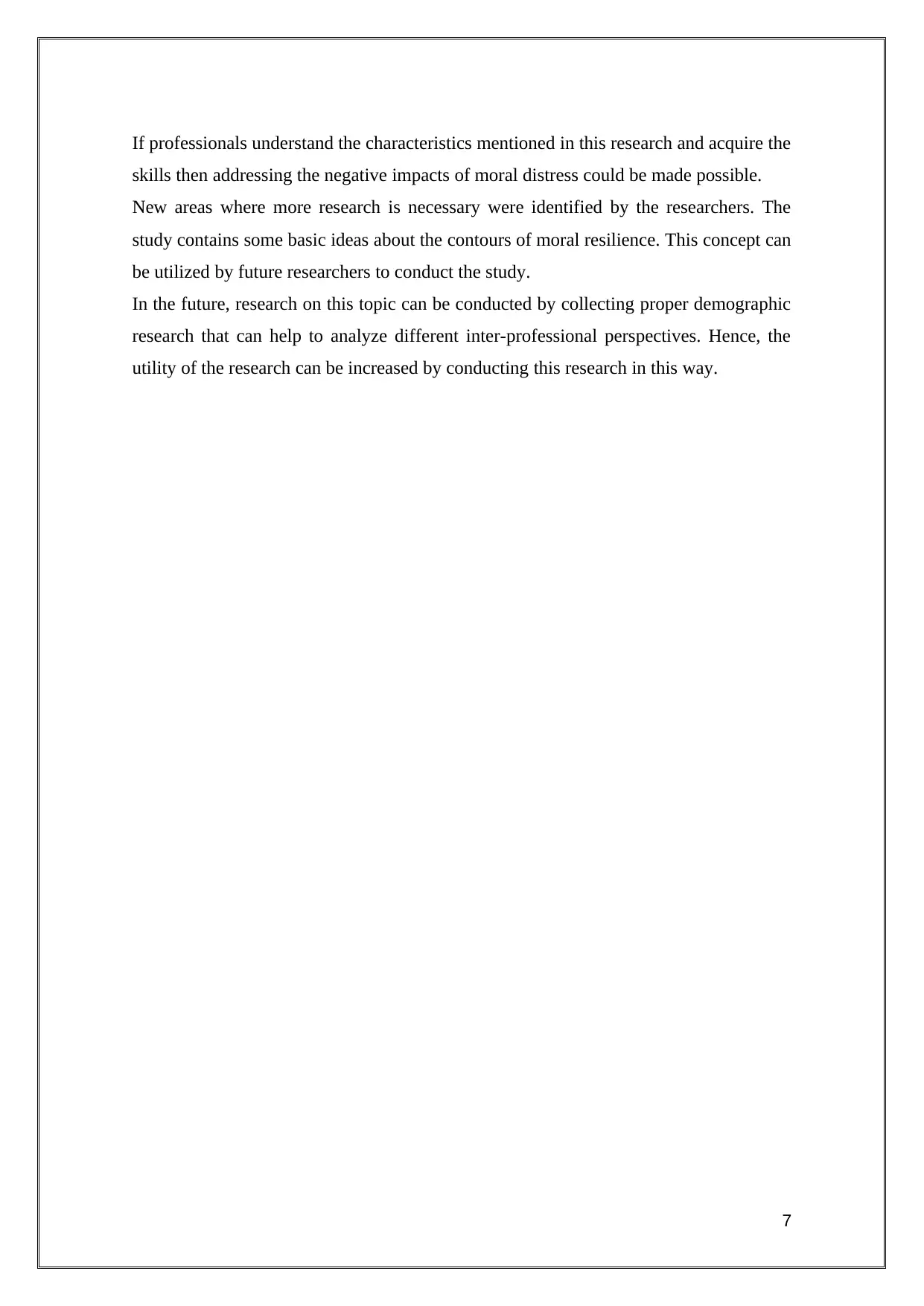
If professionals understand the characteristics mentioned in this research and acquire the
skills then addressing the negative impacts of moral distress could be made possible.
New areas where more research is necessary were identified by the researchers. The
study contains some basic ideas about the contours of moral resilience. This concept can
be utilized by future researchers to conduct the study.
In the future, research on this topic can be conducted by collecting proper demographic
research that can help to analyze different inter-professional perspectives. Hence, the
utility of the research can be increased by conducting this research in this way.
7
skills then addressing the negative impacts of moral distress could be made possible.
New areas where more research is necessary were identified by the researchers. The
study contains some basic ideas about the contours of moral resilience. This concept can
be utilized by future researchers to conduct the study.
In the future, research on this topic can be conducted by collecting proper demographic
research that can help to analyze different inter-professional perspectives. Hence, the
utility of the research can be increased by conducting this research in this way.
7
Paraphrase This Document
Need a fresh take? Get an instant paraphrase of this document with our AI Paraphraser
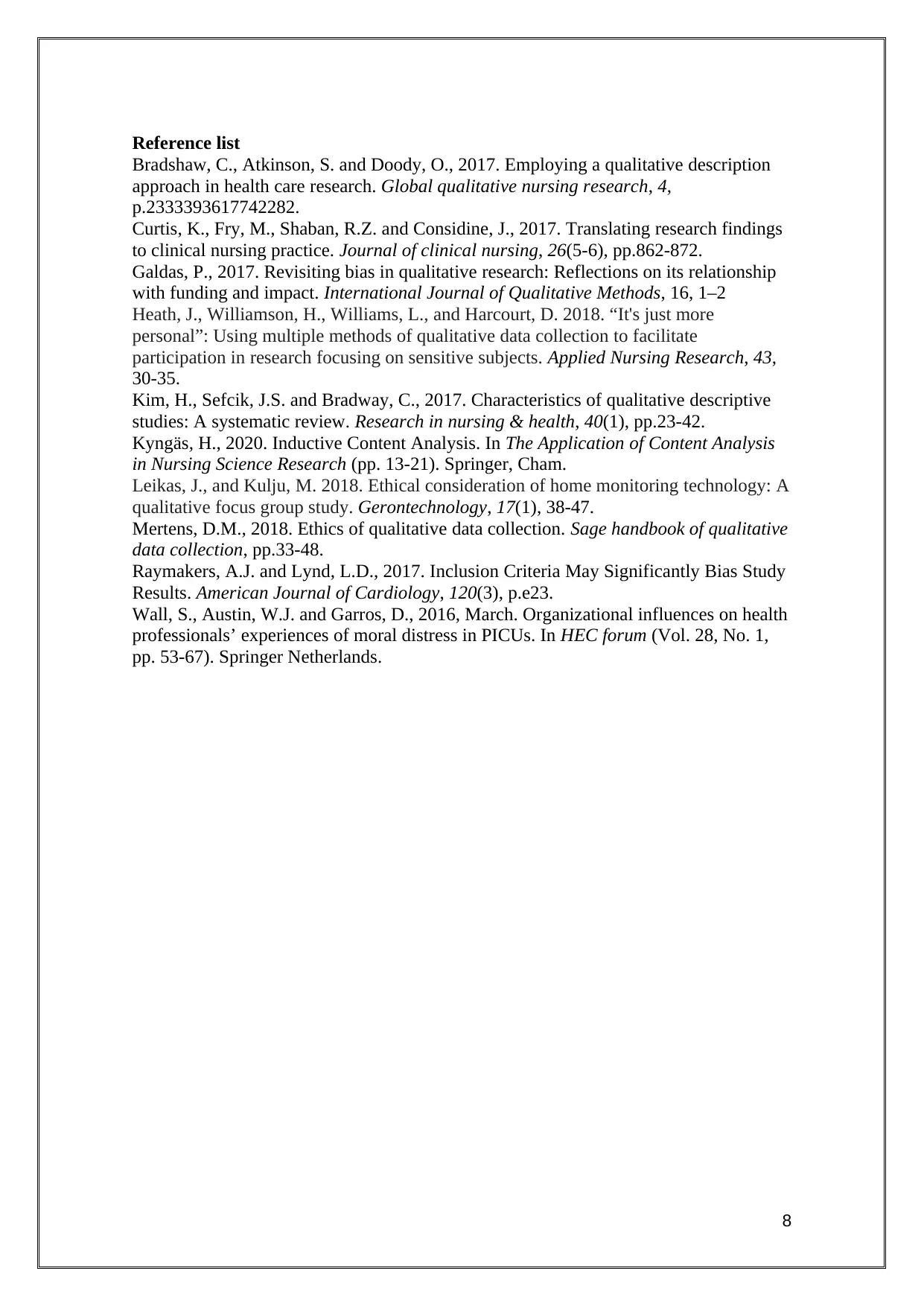
Reference list
Bradshaw, C., Atkinson, S. and Doody, O., 2017. Employing a qualitative description
approach in health care research. Global qualitative nursing research, 4,
p.2333393617742282.
Curtis, K., Fry, M., Shaban, R.Z. and Considine, J., 2017. Translating research findings
to clinical nursing practice. Journal of clinical nursing, 26(5-6), pp.862-872.
Galdas, P., 2017. Revisiting bias in qualitative research: Reflections on its relationship
with funding and impact. International Journal of Qualitative Methods, 16, 1–2
Heath, J., Williamson, H., Williams, L., and Harcourt, D. 2018. “It's just more
personal”: Using multiple methods of qualitative data collection to facilitate
participation in research focusing on sensitive subjects. Applied Nursing Research, 43,
30-35.
Kim, H., Sefcik, J.S. and Bradway, C., 2017. Characteristics of qualitative descriptive
studies: A systematic review. Research in nursing & health, 40(1), pp.23-42.
Kyngäs, H., 2020. Inductive Content Analysis. In The Application of Content Analysis
in Nursing Science Research (pp. 13-21). Springer, Cham.
Leikas, J., and Kulju, M. 2018. Ethical consideration of home monitoring technology: A
qualitative focus group study. Gerontechnology, 17(1), 38-47.
Mertens, D.M., 2018. Ethics of qualitative data collection. Sage handbook of qualitative
data collection, pp.33-48.
Raymakers, A.J. and Lynd, L.D., 2017. Inclusion Criteria May Significantly Bias Study
Results. American Journal of Cardiology, 120(3), p.e23.
Wall, S., Austin, W.J. and Garros, D., 2016, March. Organizational influences on health
professionals’ experiences of moral distress in PICUs. In HEC forum (Vol. 28, No. 1,
pp. 53-67). Springer Netherlands.
8
Bradshaw, C., Atkinson, S. and Doody, O., 2017. Employing a qualitative description
approach in health care research. Global qualitative nursing research, 4,
p.2333393617742282.
Curtis, K., Fry, M., Shaban, R.Z. and Considine, J., 2017. Translating research findings
to clinical nursing practice. Journal of clinical nursing, 26(5-6), pp.862-872.
Galdas, P., 2017. Revisiting bias in qualitative research: Reflections on its relationship
with funding and impact. International Journal of Qualitative Methods, 16, 1–2
Heath, J., Williamson, H., Williams, L., and Harcourt, D. 2018. “It's just more
personal”: Using multiple methods of qualitative data collection to facilitate
participation in research focusing on sensitive subjects. Applied Nursing Research, 43,
30-35.
Kim, H., Sefcik, J.S. and Bradway, C., 2017. Characteristics of qualitative descriptive
studies: A systematic review. Research in nursing & health, 40(1), pp.23-42.
Kyngäs, H., 2020. Inductive Content Analysis. In The Application of Content Analysis
in Nursing Science Research (pp. 13-21). Springer, Cham.
Leikas, J., and Kulju, M. 2018. Ethical consideration of home monitoring technology: A
qualitative focus group study. Gerontechnology, 17(1), 38-47.
Mertens, D.M., 2018. Ethics of qualitative data collection. Sage handbook of qualitative
data collection, pp.33-48.
Raymakers, A.J. and Lynd, L.D., 2017. Inclusion Criteria May Significantly Bias Study
Results. American Journal of Cardiology, 120(3), p.e23.
Wall, S., Austin, W.J. and Garros, D., 2016, March. Organizational influences on health
professionals’ experiences of moral distress in PICUs. In HEC forum (Vol. 28, No. 1,
pp. 53-67). Springer Netherlands.
8
1 out of 8
Related Documents
Your All-in-One AI-Powered Toolkit for Academic Success.
+13062052269
info@desklib.com
Available 24*7 on WhatsApp / Email
![[object Object]](/_next/static/media/star-bottom.7253800d.svg)
Unlock your academic potential
Copyright © 2020–2025 A2Z Services. All Rights Reserved. Developed and managed by ZUCOL.





